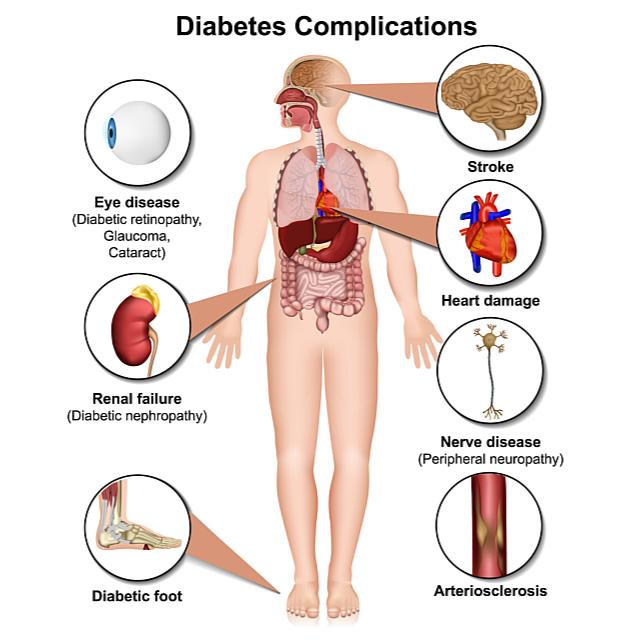Diabetes is as serious as a heart attack. Literally.
According to the Centers for Disease Control and Prevention (CDC), diabetes is a leading cause of death in the United States It is estimated that over 100,000 Americans die from diabetes-related causes each year. This number includes both deaths directly caused by diabetes, such as diabetic ketoacidosis and hypoglycemia, as well as those caused by complications of the disease, such as heart disease, stroke, kidney disease, and neuropathy.
So, why is it that in developed nations, approximately 50% of people with diabetes fail to follow the recommendations of their physicians?
Some of the factors that are cited across several studies include the cost of care, lack of understanding about the disease, lack of support from family in managing their own care, taking multiple medications, lack of access to medical care, difficulty sourcing healthy food, and not receiving helpful information from their healthcare providers.
For the purposes of this article, I’ll be focusing on the lack of understanding about the disease, in particular understanding the consequences of failing to take proper care of ourselves after we’ve been diagnosed.
For starters, let’s take a little deeper look at the complications of diabetes. The long-term complications of diabetes develop gradually. The longer you have diabetes — and the less controlled your blood sugar — the higher the risk of complications.
Eventually, diabetes complications may be disabling or even life-threatening. Knowing how damaging the complications of diabetes can be to the quality of our lives and even how long we might live, we’ll begin with the most serious and work our way down.
Heart Disease and Stroke.
If you have high blood sugar for an extended period, it can harm your blood vessels, potentially leading to coronary artery disease with symptoms such as chest pain (angina), heart attack, stroke, and narrowing of the arteries (atherosclerosis).
Coronary artery disease is a type of heart disease that occurs when the coronary arteries, which supply blood to the heart muscle, become narrowed or blocked by plaque. This can lead to chest pain (angina) or a heart attack.
A stroke occurs when the blood supply to the brain is disrupted, either because of a blockage in an artery or bleeding in the brain. This can cause brain cells to die, leading to disability or death. High blood sugar can contribute to the development of stroke by damaging blood vessels and increasing the risk of plaque buildup.
Atherosclerosis is a condition in which the arteries become narrowed and hardened due to the accumulation of plaque. Plaque is a combination of fat, cholesterol, and other substances found in the blood. When plaque builds up in arteries, it can restrict blood flow and increase the risk of heart disease and stroke.
Kidney Damage (nephropathy).
The kidneys are responsible for filtering waste and excess fluids from the blood. They do this by using tiny blood vessels called glomeruli, which are clusters of blood vessels that help to filter waste and excess fluids from the blood. In people with diabetes, high blood sugar levels can cause damage to the glomeruli, making it harder for the kidneys to filter waste and excess fluids from the blood. This is known as diabetic nephropathy, or kidney disease.
Diabetic nephropathy can cause a number of symptoms, including swelling in the feet and ankles, fatigue, and changes in urine output. If left untreated, it can lead to kidney failure, which requires dialysis or a kidney transplant.
Nerve Damage (neuropathy)
Diabetic neuropathy is a type of nerve damage that results from having high levels of blood sugar (glucose) due to diabetes. It most commonly affects the nerves in the legs and feet, but can also affect the nerves in the hands, digestive system, urinary tract, blood vessels, and heart. Symptoms of diabetic neuropathy may include pain and numbness in the affected areas.
The severity of the symptoms can vary, with some people experiencing mild symptoms and others experiencing more severe and disabling pain. It is estimated that as many as 50% of people with diabetes may develop diabetic neuropathy. However, it is often possible to prevent or slow the progression of diabetic neuropathy by properly managing blood sugar levels and adopting a healthy lifestyle.
There are four types of diabetic neuropathy, and it is possible to have more than one type at the same time. The symptoms of diabetic neuropathy depend on the type and which nerves are affected. These symptoms often develop slowly over time and may not be noticed until significant nerve damage has occurred.
- Peripheral neuropathy is a type of nerve damage that affects the feet, legs, hands, and arms. It is often worse at night and can cause numbness, tingling, burning, sharp pains or cramps, muscle weakness, and extreme sensitivity to touch. It can also lead to serious foot problems such as ulcers, infections, and bone and joint damage.
- Autonomic neuropathy affects the nerves that control the body’s organs and systems, such as the blood pressure, heart rate, and digestive system. Symptoms may include hypoglycemia unawareness, drops in blood pressure, bladder or bowel problems, slow stomach emptying, difficulty swallowing, changes in eye function, and problems with sexual response.
- Proximal neuropathy, also known as diabetic polyradiculopathy, affects the nerves in the thighs, hips, buttocks, and legs and may cause severe pain, weak and shrinking thigh muscles, difficulty rising from a seated position, chest or abdominal wall pain.
- Mononeuropathy, or focal neuropathy, is damage to a single nerve and can cause problems such as difficulty focusing, paralysis on one side of the face, numbness or tingling in the hand or fingers, weakness in the hand, pain in the shin or foot, weakness in lifting the front part of the foot, and pain in the front of the thigh.
If you have any of these symptoms, it is important to see a doctor for an evaluation.
Eye damage (retinopathy).
Diabetes can damage the blood vessels of the eye (diabetic retinopathy). This could lead to blindness.
Diabetic retinopathy is a condition that can occur when high levels of sugar in the blood damage the tiny blood vessels that nourish the retina, the light-sensitive layer at the back of the eye. When the blood vessels become blocked, the eye may attempt to grow new blood vessels. However, these new blood vessels often do not develop properly and can leak easily.
There are two types of diabetic retinopathy: early diabetic retinopathy and advanced diabetic retinopathy.
- Early diabetic retinopathy, also known as nonproliferative diabetic retinopathy (NPDR), is the more common form. In NPDR, the walls of the blood vessels in the retina weaken and bulges may protrude from the walls of the smaller vessels, sometimes leaking fluid and blood into the retina. Larger retinal vessels may also dilate and become irregular in diameter. NPDR can progress from mild to severe as more blood vessels become blocked. If the damage to the blood vessels in the retina leads to a buildup of fluid in the center of the retina (called macular edema), treatment may be needed to prevent permanent vision loss.
- Advanced diabetic retinopathy, also known as proliferative diabetic retinopathy, is a more severe form of the condition. In this type, damaged blood vessels close off, leading to the growth of new, abnormal blood vessels in the retina. These new blood vessels are fragile and may leak into the vitreous, the clear, jelly-like substance that fills the center of the eye. Scar tissue from the growth of these new blood vessels may cause the retina to detach from the back of the eye. If the new blood vessels interfere with the normal flow of fluid out of the eye, pressure may build up in the eye, which can damage the optic nerve and lead to glaucoma.
Foot Problems
In the United States, every year about 73,000 amputations of the lower limb not related to trauma are performed on people with diabetes. It all starts with a foot ulcer that doesn’t heal. Of diabetic foot ulcers that do not heal, 25% will require amputation.
The high blood sugar levels associated with diabetes can damage the nerves and blood vessels in the feet, leading to a loss of feeling and impaired circulation. This can make it more difficult for sores and cuts to heal, increasing the risk of infection and amputation.
Peripheral neuropathy and the associated loss of feeling in the feet make it difficult to detect cuts, blisters, or other injuries. As a result, people with neuropathy may not realize they have an injury until it has become infected or developed into a wound.
High blood sugar levels can also damage the blood vessels in the feet, leading to poor circulation. When the circulation is impaired, it can take longer for sores and cuts to heal, increasing the risk of infection. In severe cases, amputation may be necessary to prevent the spread of infection.
Sexual Problems
Among Men: Erectile dysfunction (ED) is a common complication of diabetes in men. This occurs when the small blood vessels that supply the penis are damaged, a condition known as microvascular disease or microvascular endothelial dysfunction.
High blood sugar levels can also damage nerves, which can affect the process of getting and maintaining an erection. Men with diabetes may also have abnormal levels of fat and cholesterol, which contribute to blood vessel damage and increase the risk of ED. Heavier weight and lower testosterone levels, which are common in men with diabetes, can also contribute to ED.
In addition, people with diabetes are more likely to have mental health issues, such as depression, which can also cause ED. Certain medications used to treat diabetes or related conditions may also have side effects that contribute to ED.
Among Women: Vaginal dryness can be a common issue for women with diabetes due to damaged blood vessels and restricted blood flow in the vagina. This can lead to a lack of lubrication and make sex painful. Certain medications, such as antidepressants and blood pressure medications, can also contribute to vaginal dryness.
Thrush, a fungal infection, can also be more common in women with diabetes due to high sugar levels in urine, providing a favorable environment for the growth of the bacteria that causes thrush. Symptoms of thrush can include itchiness and pain around the vagina, discharge, pain during sex, and stinging when urinating.
Skin Problems
People with diabetes are more prone to developing skin problems due to the high levels of sugar in their blood. High blood sugar levels can damage blood vessels and nerves, which can lead to problems with circulation and sensation in the skin. This can make it more difficult for the skin to heal and can increase the risk of infection.
Diabetes can also cause changes in the skin’s pH balance, which can lead to dry, itchy skin. Additionally, high blood sugar levels can affect the body’s ability to produce collagen and elastin, which are proteins that help keep the skin healthy and supple. This can lead to the development of wrinkles and thin, fragile skin.
There are several skin problems that are more common in people with diabetes, including:
- Bacterial infections: High blood sugar levels can make it easier for bacteria to grow and multiply, which can lead to infections such as cellulitis and folliculitis.
- Fungal infections: Diabetes can also increase the risk of fungal infections such as athlete’s foot and jock itch.
- Dry skin: Diabetes can cause the skin to become dry and itchy, which can be uncomfortable and may lead to skin problems such as dermatitis.
- Slow-healing wounds: High blood sugar levels can slow the healing process, which can make it more difficult for cuts, scrapes, and other injuries to heal.
- Necrobiosis lipoidica diabeticorum (NLD): This is a rare skin condition that causes patches of skin to become red, swollen, and painful. It typically affects the lower legs and is more common in people with poorly controlled diabetes.
Oral Health Problems
Diabetes can have a significant impact on your oral health. High blood sugar levels can also affect the sugar levels in your saliva, which can provide food for bacteria in plaque, a sticky film that can cause tooth decay, cavities, and gum disease. If left untreated, tooth decay can lead to tooth loss.
Gum disease can be more severe and take longer to heal if you have diabetes. Additionally, diabetes can cause dry mouth, inflammation and bleeding of the gums, and slower healing of infections in the mouth.
Hearing Problems
People who have diabetes are twice as likely to experience hearing loss as those of the same age who do not have diabetes. Even individuals with prediabetes (elevated blood sugar levels that have not yet reached the threshold for type 2 diabetes) are 30% more likely to experience hearing loss than those with normal blood sugar levels.
According to the Centers for Disease Control and Prevention (CDC), prolonged high blood sugar levels can damage small blood vessels and nerves in the inner ear, while prolonged low blood sugar levels can impair the transmission of nerve signals from the inner ear to the brain. Both types of nerve damage can result in hearing loss.
Mental Health Challenges
The complications discussed thus far are physical manifestations of diabetes, but the emotional and psychological side of the disease can be just as important on a day-to-day basis.
Managing diabetes can be a lot of work and can lead to feelings of burnout, which can be compounded by a higher likelihood of developing depression. People with diabetes are 2 to 3 times more likely to have depression than people without diabetes.
It’s important to pay attention to your emotional well-being while managing your diabetes, as untreated depression can worsen over time.
It’s estimated that between 25% and 50% of people with diabetes who experience depression receive a diagnosis and treatment, but treatment options such as therapy and medication can be effective in managing the condition.
Diabetes and Dementia
There may be a link between Alzheimer’s disease and type 2 diabetes, but it is not fully understood. Some people say that Alzheimer’s is “diabetes in the brain”, but may be an oversimplification of the scientific data.
It is thought that untreated diabetes may cause damage to blood vessels in the brain, leading to chemical imbalances that may trigger Alzheimer’s. High blood sugar levels may also lead to inflammation, which can damage brain cells.
This is why diabetes is considered a risk factor for a condition called vascular dementia, which can either be a stand-alone diagnosis or a warning sign of what may develop into Alzheimer’s disease. However, it is worth noting that there are cases of Alzheimer’s disease and other forms of dementia that do not have any demonstrated link to insulin resistance.
In conclusion…
Diabetes is a serious and potentially life-threatening disease that can lead to a range of complications if not properly managed. Serious, life altering complications can include heart disease, stroke, kidney damage, nerve damage, eye damage, and amputation. Less serious, but still worth noting, are complications involving sexual problems, skin problems, oral health problems, hearing problems and mental health problems.
It is important for individuals with diabetes to follow the recommendations of their healthcare providers in order to manage their blood sugar levels and reduce their risk of developing these complications. That’s a starting point.
In my opinion, the single most important thing we can do to manage our diabetes is to take charge of our current and future health by practicing good self care. That includes regular blood sugar self testing, eating properly, getting regular exercise, drinking plenty of water to stay hydrated, taking and adjusting medications as needed, and doing regular foot checks.
###
Remember, self-care matters. Every step we take, every decision we make to better manage our diabetes makes a difference in how well and how long we live. Choose wisely. Live long, love life and be well.
The information on this site is not intended or implied to be a substitute for professional medical advice, diagnosis or treatment. The information on this site is for informational purposes only and is not intended to diagnose, treat, or cure any type of disease or condition. Diabetes Control Today does not guarantee any results for your specific situation. In support of our website, we may share resources offered by trusted partners. If you purchase products from any of these partners, the owners of this site may receive a portion of the proceeds. These affiliations allow us to continue bringing you valuable, potentially life-changing content.






